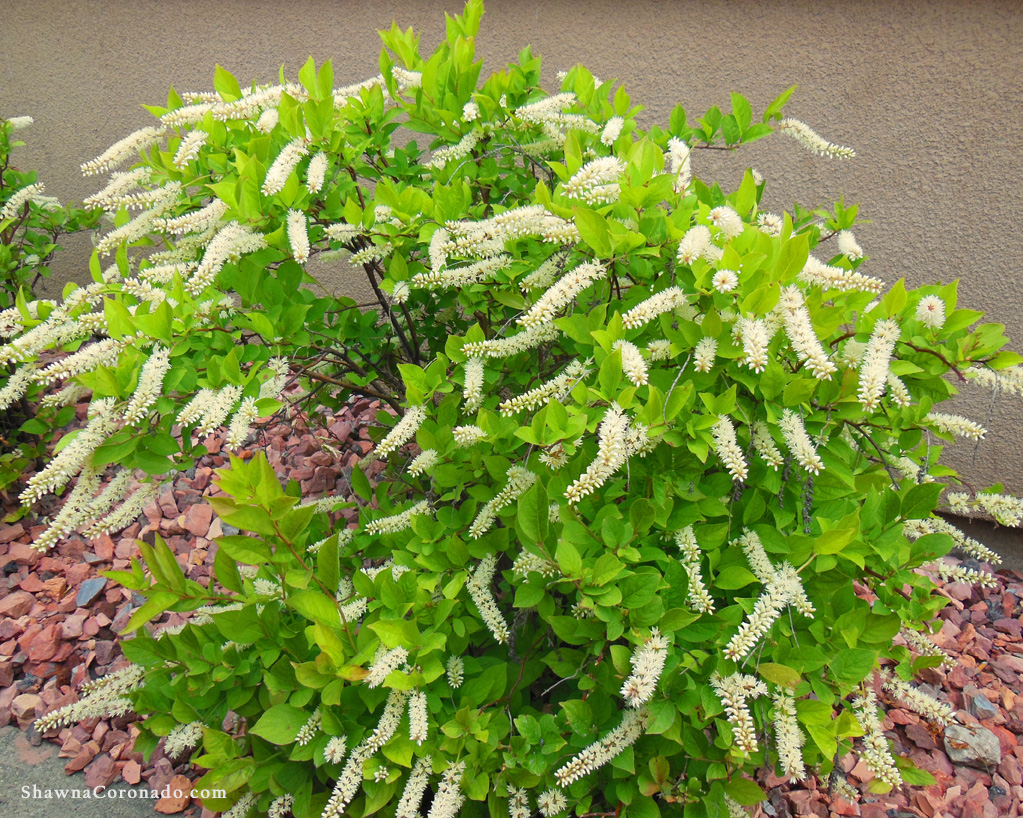Grow Summersweet Clethra as a Wet Soil Garden Solution

How to Grow a Summersweet Clethra or Clethra alnifolia Shrub
Pollinators love the Summersweet clethra shrub also known as Sweet Pepperbush or Clethra alnifolia. This shrub blooms in midsummer and is deer- and pest-resistant. Learn how Summersweet Clethra grows in this post and you will have amazingly sweet-scented flowers bloom throughout the heat of the season.
Great Fall Colors –
Clethra alnifolia has warm golden-yellow leaves in the fall. While you can grow Summersweet Clethra as a highly attractive shrub, it can sometimes overstep its bounds. In order to keep it in bounds, plant the shrub near a wall, fence, or sidewalk border. This planting technique will help keep the plant’s suckering roots contained and well managed.
Controls Erosion and Standing Water –
Grow Summersweet Clethra as a utilitarian shrub by using it for challenging landscape situations such as controlling erosion or preventing standing water issues. This is a great shrub for hillsides or wet ravines. Below is an excerpt from the Indiana Getting Started Gardening Guide which can give you further ideas on how to grow this shrub.
When, Where, and How to Grow Summersweet Clethra
- Botanical name — Clethra alnifolia
- Bloom Period and Seasonal Color — Early summer; white and pink flowers
- Mature Height × Spread — 4 to 8 feet × 4 to 6 feet
- Added Benefits – Loved by pollinators and butterflies. Fruit and seeds are enjoyed by birds.
- Sun Requirements – Sun, Part-Sun – Garden Zones 4-9
Summersweet clethra grows best in fertile, well-drained, moist soil with full sun to part shade exposure. Amend soil with organic matter to improve it or consider raised beds if your site lacks drainage. Plant it in the spring by digging a hole in a well-drained planting area that is the same depth as the rootball and twice as wide. Place the top of the rootball so that is level with the ground.
Tips on How to Grow Summersweet Clethra or Clethra alnifolia –
Water the shrub’s root system well upon initial planting. Summersweet Clethra grows in moist soils and should never be left to dry out for best results. Mulch the soil with a 3-inch layer of organic matter to help it hold water and protect it from the winter cold. Only fertilize with organic fertilizer before new growth occurs in the spring if the plant shows signs of undernourishment. Heavy fertilization can increase suckering and reduce flower production.
Watch Out for Suckers –
Root suckers are produced freely when growing Summersweet Clethra once the plant is established. Obviously, these can form very large colonies. The solution is to spade the roots around the base of the shrubs back annually. Summersweet blooms on the current year’s growth, so the best time to prune the bush is in late winter before the new buds have set on the limbs.
Planting and Design –
How to grow Summer Sweet Clethra shrub as a companion plant is to keep in mind its nature. Obviously, this shrub is a glorious blooming solution for rain gardens and prevents erosion on hillsides. It’s appealing as a naturalized plant, but be careful when naturalizing in woodlands as the suckering plant can take over large areas of the forested landscape. Summersweet is surprisingly tolerant of salt spray and makes a good choice to line walkways that might be salted.
Best Varieties of Summersweet Clethra for your Garden –
Grow Summersweet Clethra ‘First Snow’ for its variegated and interesting leaf color (photo above right). As a colorful alternative, ‘Ruby Spice’ is grown for its deep reddish pink-flowering blooms which arch to 6 feet tall and 4 feet wide. ‘Hummingbird’
attracts hummingbirds and butterflies with its white spiky flowers. This shrub requires constantly wet soils. ‘Sixteen Candles’ grows 3 feet tall with large, upright white flower spikes.
Would you like to know more about shrubs and plants, particularly for gardens in the Midwest? Please get my book, the Indiana Getting Started Garden Guide.

Will Clethra alnifolia tolerate full shade?
Grow Summersweet Clethra or Clethra alnifolia in part shade as it does remarkably well in many different lighting situations including full sun and part shade. However, these shrubs may produce fewer blooms in deep shade conditions.
Hummingbirds and other nectar-loving birds adore clethra’s beautiful sweetly scented nectar-filled flowers. Finches, robins, and warblers are attracted to the shrubs’ seed pods which develop soon after the flowers fade.
Clethra spreads through roots that are suckering and can form wide colonies. This expansive growth happens after about the third year the plant is in place. This rooting growth can be contained if placed in a confined area near a patio or sidewalk which will not enable root expansion.
Most people who smell the clethra can describe it as mesmerizing and unforgettable. Intense and easily sniffed from 100 feet or more, the scent of a clethra attracts bees, butterflies, and people alike. Many compare the fragrance to clove or honeysuckle and describe it as spicy.



